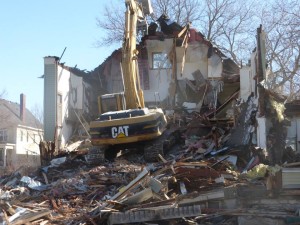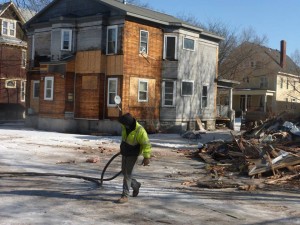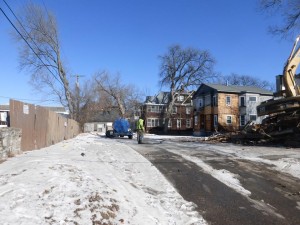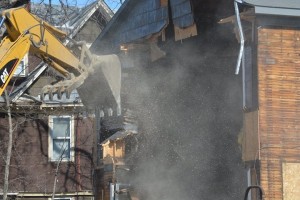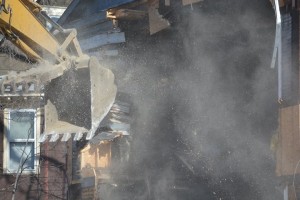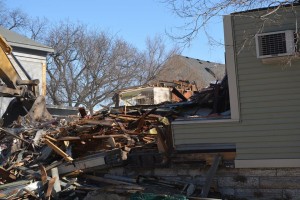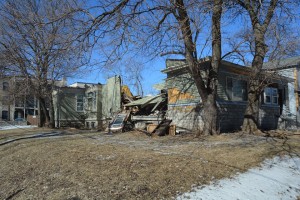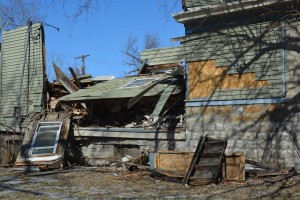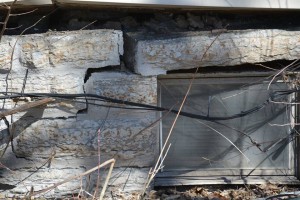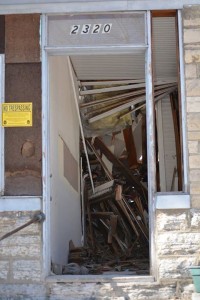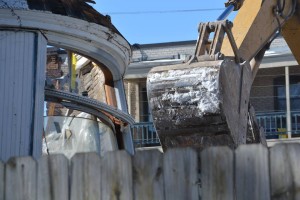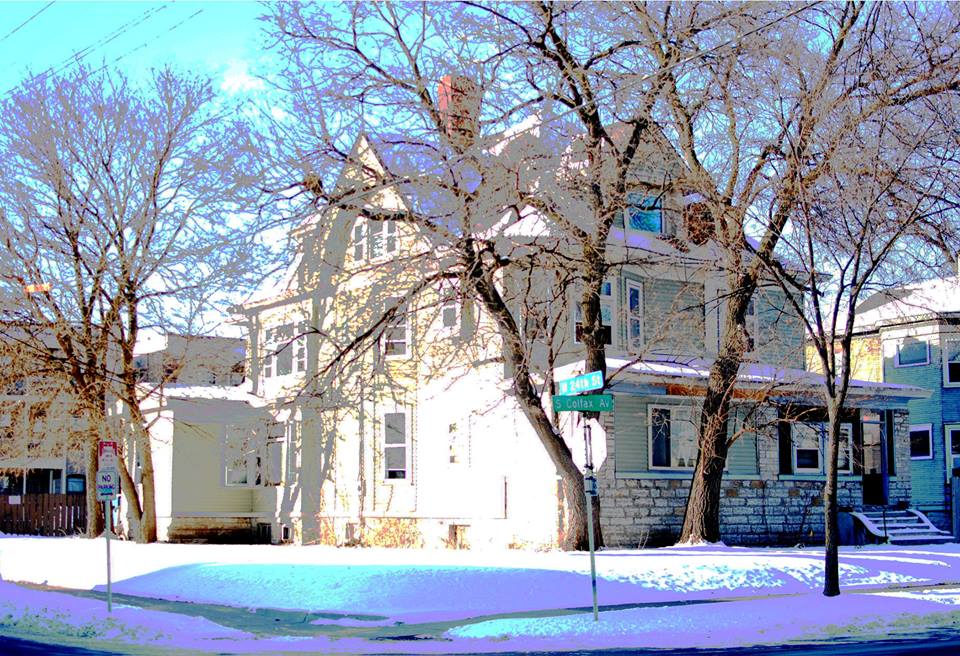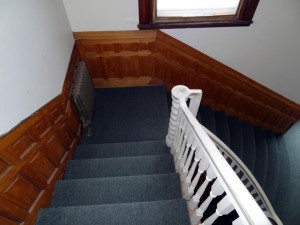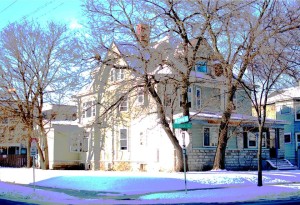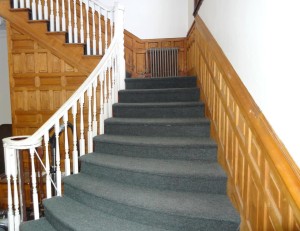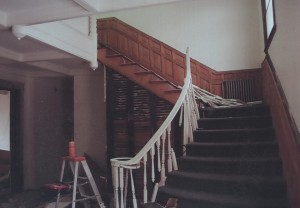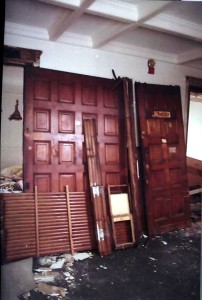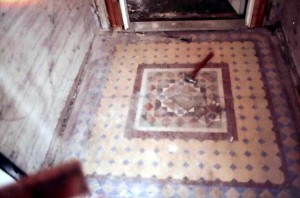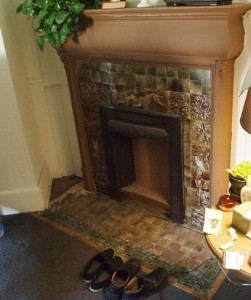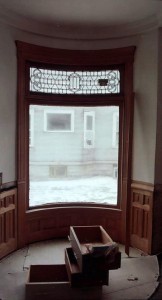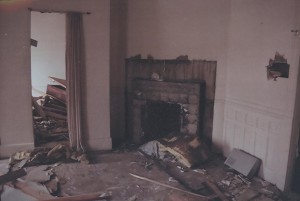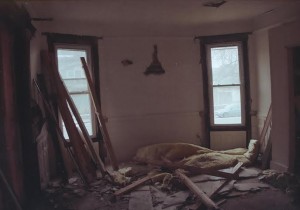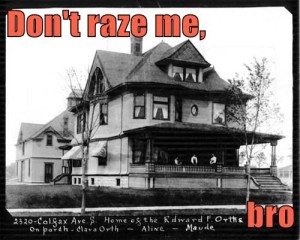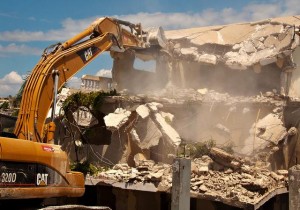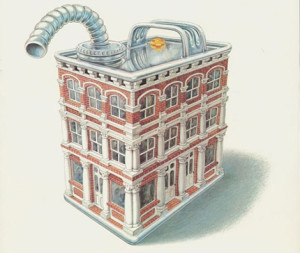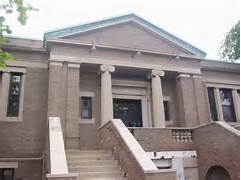
Welcome to the
Healy Project
Join us on Facebook
Send us an Email
Orth House Demolition
On the morning of February 25th, excavation trucks turned up on site at 2316-2320 Colfax Avenue South. Then came the backhoe. By around 9 o’clock, demolition was under way. The backhoe went at the Orth House all day, but still hadn’t completely demolished it. Compare that to the usual time it takes to demolish a modern dwelling–less than an hour.
See video and stills of the demolition here.
Two men worked on the demolition, one on the backhoe and another guy walking around seemingly aimlessly, heedless of peril from lead-filled particulates and falling debris. Neither wore respirators to protect themselves from the toxic dust. At one point the machine operator knocked the chimney and a large chunk of the front gable and cornice onto the front of the backhoe. The site was not roped off, and at times debris fell onto the sidewalk.
Brian Finstad, who watched the demo, reported on this OSHA nightmare: “The Orth House demolition was done without proper procedure for lead containment. Neighbors watched as literally plumes of lead contaminated dust rose into the air and on a very windy day disbursed upon the neighborhood. Only after well into an hour into the demolition (and they probably realized they were being photographed) did they bring out a hose to spray down the dust, but even that was only a token effort and the contaminate continued to disburse into the neighborhood.”
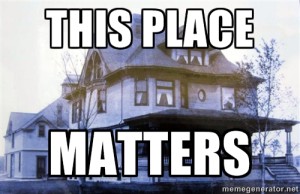
The Orth House, built by master builder T.P.Healy, 1893. Wrecked by Michael Lander, with the aid of CM Lisa Bender, 2015.
Le roi est mort, vive le roi! The Orth House is gone, long live the legacy of T,P. Healy, King of the Queen Anne!
Photo credits: Anders Christensen, Will Lumpkins, Trilby Busch, Bob Roscoe.
–T.B.
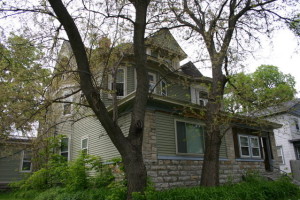
2320 Colfax Ave. S. aka the Orth House, as it appeared on the Healy Project’s first Wedge walking tour, May 2010.–Photo by Trilby Busch
The previous post showed how owner Mike Crow repeatedly gave false testimony during public hearings and in court in order to get a demolition permit for his property at 2320 Colfax Avenue South. His lies were then passed on in the testimony of City Planner John Smoley.
This post turns to the others who perpetrated these lies: the Lander Group’s hired credentialed preservation expert, Amy Lucas; the owner’s real estate broker, Tom Dunn; and Pete Keely of Collage Architects, head of the Lander Group’s development team.
In the fall of 2012, Michael Lander’s architect Pete Keely made a presentation of the plans for a proposed apartment building at 2316-2320 Colfax before the Lowry Hill East (Wedge) Neighborhood Association. Most of the meeting was devoted to showing plans and explaining the project. The meeting was packed with local residents, of which a sizable majority were opposed to wrecking the two houses on the site.
As controversy grew over the proposed demolition of the Healy-designed house at 2320 Colfax Avenue South, the pro-demolition forces seized on Crow’s public statements about its condition, setting up an echo-chamber effect in their individual statements.
Amy Lucas of Landscape Research, who had been hired by the developer to assess 2320’s historic importance, agreed with City Planner Smoley’s findings in the initial Staff report (September 25, 2012), specifically, that the property did not meet the criteria for local designation “due to lack of historic significance.”
In a letter to Pete Keely (December 12, 2012) Lucas reports: “Fires in 1991 and 2011 have left little interior fabric. The second and third floors have been completely rebuilt; the first floor entry hall retains some wood paneling and stair railing. . .The house at 2320 Colfax Avenue South has extensive integrity issues and is no longer representative of an intact Healy design.”

Neighborhood showdown vote: The Lander apartment proposal fails to win the approval of the LHENA Board. Lucas and Keely testified for the developer. January 16, 2013.–Photo by Anders Christensen
Lucas presumably went through the house, yet for some reason she did not observe any of the appointments and architectural features that remained in the private rooms on the first and second floor, and instead repeated what Crow had said about the house, namely, that fire had destroyed the upper two floors.
Throughout the hearings on 2320 during 2012-2013, Lucas’s opinion remained completely in line with owner Mike Crow’s testimony. In her Historic Evaluation of 2320 in March 2014, Lucas reports: “The second and third floors were burned and the 1992 rehabilitation removed flooring, walls and doors. The plan of the upper floors was also changed during the renovation. At the interior, the second and third floors were completely reconfigured after the 1991 fire; all historic fabric was removed from these floors. [. . .]The house at 2320 Colfax Avenue South maintains its historic location, but possesses poor integrity in setting, design, materials, and workmanship. The house burned in 1991 and has been converted into a rooming house. The majority of the historic features and historic materials have been removed and/or covered.”
At the Heritage Preservation Commission’s hearing on March 18, 2014, on Crow’s appeal to issue a demolition permit for an historic resource, Lucas testified: “I don’t know if any of you have been in the house, but when it burned the second and third floors burned completely. So they were rebuilt as small rooms upstairs. [. . . ] [The house] today no longer has the integrity of its original design. The interior has been muddled greatly.”
Ironically, she allegedly had been inside the house, examining it for her report, yet somehow she did not see that the layout and rooms on the second floor were intact in their original configuration. The existing cove ceilings and baseboard trim revealed during salvage operations strongly suggest minimal to no changes there.
In District Court in May of 2014, Lucas gave similar testimony. Although John Smoley acknowledged to the court that Anders Christensen’s research is the primary source of information about T.P. Healy’s work, under cross-examination, Lucas would not acknowledge Christensen’s expertise, suggesting that somehow she got her information from other sources.
In preparation for that March hearing, Collage Architects, represented by Pete Keely, submitted a memo to the HPC on behalf of the Lander Group Development Team (February 17, 2014). This memo contains the same inaccuracies as Lucas’s, and throws around some figures for good measure: “Although this property was designed and constructed by T.P. Healy, the home is nothing close to the original construction. Over 75% of the original materials in the home have been replaced due to extensive fires, and insensitive remodeling.[…]2320 Colfax has extensive integrity issues and is no longer representative of an intact Healy designed home. Nearly all of the construction above the first floor and most of the first floor are not Healy constructed components as these have all been replaced.[…]
Over 75% of the home has been changed. This house is beyond restoration and would require re-construction [sic] to bring it back to the home originally designed and constructed. Approximately 80% of the original siding is severely damaged or missing and was a major cause for the re-siding in 1960 and 2003.”
One wonders where they got the figures from–clearly, not from looking into the rooms and under the top siding.
At the hearing Pete Keely reaffirmed the claims articulated in the memo: “We are here to say that the integrity of the home, the usefulness of the home has gone away. [. . .]There is really not much left of that original home, and so in terms of the integrity which has already been talked about, the dollars put forth into it already muddy waters as to what is real or not real.”
One can certainly agree about the “muddying waters” aspect of this testimony, not to mention the ironic “what is real and what is not”.
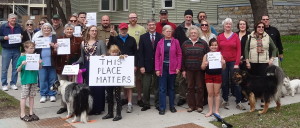
Humans and canines assemble in front of the Orth House to proclaim, “This Place Matters” to the National Trust for Historic Preservation, May 5, 2014–Photo by Bradley Lemire
Another person who stood to reap significant gain by bringing 2320 down is real estate broker Tom Dunn. His aptly named company is called Terra Firma, that is, Latin for ‘land”–not Domum for “home”. Dunn contended from the beginning that he had tried to sell the house as investment property, but failed. He asserted over and over that the rooming house rental model is no longer financially feasible, and that he could not find a buyer interested in the house as a residence.
When asked point blank at a Zoning and Planning Committee hearing if he had offered the house for sale via the Multiple Listing Service, Dunn answered, “Yes.” ( May 21, 2013). However, a check of MLS records finds no evidence that Dunn ever listed the house on the service, revealing a lie that is solely of Dunn’s doing.
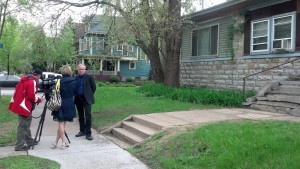
Anders Christensen being interviewed by a KARE11-TV reporter in front of the Orth House after the HPC rejected Mike Crow’s appeal to demolish an historic resource, March 5, 2014–Photo by Ceridwen Christensen
At the March 2014 HPC hearing on the appeal to demolish an historic resource, Dunn waxed metaphorical in an extremely ironic plea for commissioners to see through the “myths” about 2320:
“I want you to listen to the facts as they are being presented. Did you know that the Vikings didn’t have horns on their helmets? They didn’t have horns on their helmets. That was a rumor started by ancient Romans and that’s a myth that’s been perpetuated throughout time and that’s essentially what’s being done. A myth of the historic nature of this building when there really is none. So I really want you and encourage you to listen to the facts. [. . .]
There is just no reason to stand in the way of allowing this project to go forward, other than based on some logic that you’re committed to a cause of some kind. But in this instance it really doesn’t have any relevance. So I just want you to listen to the historic nature, to what the experts are saying about the historic significance of this property. There just isn’t any.”
Dunn went on to repeat similar testimony in District Court. If we can believe Crow and his attorney, the sale price of the two parcels at 2316-2320 Colfax as land is $950,000. When the sale to the Lander Group closes, Dunn will receive a commission well into five figures.
As the icing on the cake of lies, at the hearing in District Court on December 18, 2014, Crow’s attorney Stephen Harris told the judge that closing on the property would take place on December 22, 2015. Harris asked for a bond of $950,000 should the judge grant an injunction against demolition. Yet as of January 20th, no sale had been recorded, the house was still standing, and Crow has been seen repeatedly going in and out of it. UPDATE: The demolition permit was issued on February 19, 2015, after it was sold to Lander. The house was wrecked on the 25th). Why did Harris tell the judge that the sale was closing just days after the hearing? Is that what Crow told him, or did he make it up in order to get the judge to require a very high bond? Did both of them know that Lander would be doing the demolition?

The Orth House did matter to many of us, but for certain City officials, it mattered only as an obstacle to their plans for new development.
Throughout the two-year-long process of hearings, demolition advocates repeated the same false testimony: that fires had completely destroyed the second and third floors; that the upper floors had been completely rebuilt and reconfigured after the ’91 fire; that remodeling had removed the “historic fabric” of the house; that what was left of the original features was visible in the public spaces; that the house was so far gone it would take a fortune to rehab. Not one of these claims could be supported by a close examination of the house itself.
Owner Mike Crow was careful to allow access only to the entryway, hallways, and front parlor when he showed the house. But does this excuse those whose testimony apparently was based only on the appearance these spaces? Did these people, who will benefit financially from getting the Lander development project through, bother to question Crow’s assertions? Did they examine the private spaces of the house? If so, how did they fail to see and to report what was revealed by the salvage operations in December?
Jonathan Swift’s observation that “Falsehood flies, and the truth comes limping after it” is a good assessment of what happened during the process of testimony regarding the importance and condition of the Orth House at 2320 Colfax Avenue South. It’s both infuriating and heartbreaking that the truth was revealed only as the house was undergoing demolition.
Some of us have little trust in the City’s resolve and even desire to correct this corrupted process. Will truth have to keep limping behind lies in public testimony? Only time will tell.
–T.B.
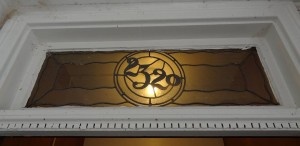
The leaded glass transom over the front door in March 2013, removed by the salvage company in December 2014.–Photo by Trilby Busch
A previous post reported that the salvage operation preparatory to the demolition of the 1893 Healy-designed house at 2320 Colfax Avenue South, aka the Orth House, revealed that most of the architectural features of the house were intact.
A subcontractor involved in the salvage operation sent this e-mail to the Healy Project:
“So many people have either lied or credulously accepted lies about the interior of 2320 Colfax. I’d talked my way into a couple of rooms earlier this year so I knew there was more there than they were letting on but I had no idea… The entry, all 3 parlors and the dining room were essentially the same as you see them in those 2 old interior photos on the Healy site. Wainscoting, window & door casings, cove & coffered ceilings, huge paneled pocket doors, it was all there. The cased openings between parlors and about 4 feet of the North end of the dining room were sectioned off with easily removable drywall partitions.
The real surprise, however, was the 2nd floor, purportedly ‘gutted’ by fire. 5 of 6 bedrooms had all of their original millwork, cove ceilings, pocket doors, 10-panel closet doors. One of the bedrooms had a fireplace with a brown ceramic face/hearth and with a cabinet built into the wood surround. The only things new in each of these rooms were their doors communicating to the central hall. Anyone taken upstairs could be easily led to believe that the floor was a drywall gut-job, as long as they were kept in the hallway.
The 3rd floor still had some original millwork but, as was so often the case, it was relatively plain.
Seriously, this could’ve been a million-dollar house.”

This was taken mid-December. It’s from 2320 Colfax, showing part of the coffered ceiling and just a small bit of the wainscoting in the dining room. All of that is either black cherry or 1/4-sawn white oak, painted over with white acrylic. Those panel sections are just 3 of dozens that are in my basement now, along with I’m not sure exactly how many door and window casings (I lost count) – also 1/4-sawn white oak. Many other bits, as we know, are at City Salvage. When I last saw the interior there was a vast amount of mill-work still in place, waiting for the backhoe bucket that will tear it all to splinters. See the link below to some videos and photos taken the week of 9-12 December, 2014. I’m working on some caps from the video as it’s so Blair Witch shaky. Keith Lawrence was in there independently during the day on 9 December. He caught a lot of detail that was already gone by the time I finally got a chance for photos & videos about 12 hours later, in the wee hours of 10 December.–Subcontractor Ezra Gray.
To get to the link showing photos and video taken by Ezra Gray, click here.
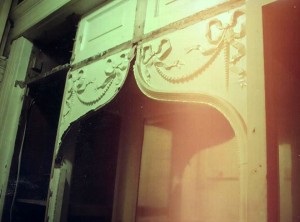
The painted dining room buffet, with its distinctive garlands, being removed for salvage, December 2014.–Photo by Keith Lawrence

The dining room buffet is shown in this century-old photo from the Orth Family collection–Photo courtesy Keith Lawrence
This post will outline the process by which a property owner, by repeatedly lying, finally got City officials to issue a demolition permit for a mostly intact 1893 house that had been declared an historic resource.
Owner Mike Crow repeatedly misrepresented the condition of a house he wanted to sell as land. At neighborhood meetings, before the Minneapolis City Council and Heritage Preservation Commission, and in District Court, Crow asserted again and again that there was nothing left of the original, historic house at 2320 Colfax Avenue South.
At the hearing before the Heritage Preservation Commission on April 13, 2013, Crow testified: “The only pictures he [Anders Christensen] showed you is the only part of the house that still has anything left, and a good portion of that is not the original house. Everything on the second and third floor was completely gutted.”
The Minneapolis Planning Department, apparently eager to get the house down and the Lander Group’s apartment building up, accepted Crow’s word on faith, without visiting the site. Basing his opinion on four exterior photos instead of on an examination of the house itself, John Smoley, preservation expert for the Planning Department, repeated Crow’s assertions: “Fires in 1991 and 2011 have left little interior fabric. The second and third floors have been completely rebuilt [. . . ] 2320 Colfax has extensive integrity issues and is no longer representative of an intact Healy house.”
Thus began the spreading of the big lies about 2320: That fires had destroyed the upper two floors, that the second and third floors had been completely rebuilt, removing all of the original appointments, and that the only original components were those visible in the entryway and a front parlor.
Despite these assertions by Crow and Smoley, the HPC declared the house at 2320 Colfax Ave. S. an historic resource. In May, by unanimous vote, the Minneapolis City Council, after hearing the same testimony that Crow and Smoley had presented to the HPC, reaffirmed the HPC’s declaration. The house was officially declared an “historic resource” of the City of Minneapolis.
However, after the 2013 election, Crow decided to appeal the HPC’s decision. In his request for a permit to demolish an historic resource (January 8, 2014), Crow declared: “We purchased the building in 1991 after it had been severely damaged in a fire. The second and third floors were taken down to the studs and rafters. Nothing on the 2nd and 3rd floor survived other than apiece [sic] of trim here and there, every room in the house had some damage from the smoke, fire or water. There is not one single room that is in its original state. The only two rooms that are the most intact in the entire building are the foyer or entry and the original living room with fireplace.”
Ironically, throughout this process, Crow had been adamant in insisting that if people had seen the house, they would know that his description was accurate—This despite the fact that he had shown the house to several representatives of the Healy Project–but not to John Smoley.
Smoley made his first on-site visit to the house in January 2014 in preparation for the HPC hearing on March 18th. Even after seeing the physical house, in the staff report for the hearing, Smoley repeated Crow’s assertions in architectural jargon:
“The property does not retain integrity of materials. The majority of the building’s original exterior and interior materials have been replaced or covered.. . Remodeling on the first floor has been very heavy, though nowhere near as extensive as on the second and third floor spaces. There, the character is almost completely late twentieth century due to a comprehensive 1980s-era remodel designed to repair fire damage. [. . .] Integrity of workmanship is evident in very few remaining exterior features apart from two bow windows and a brick chimney high atop the roof. On the interior, first floor spaces provide limited evidence of late nineteenth century craftsmanship, separated by far more evidence of late nineteenth century work. In any event, the presence of these few, scattered historic features is not sufficient evidence for this residence to retain integrity of workmanship or integrity in general.”
After hearing their testimony, Commission Sue Hunter-Weir commented: “[A] year ago we looked at this property; we knew about the fire, we knew about the siding, we knew all of those things and still thought of this property as an historic resource and that was appealed to both Zoning and Planning and City Council and they upheld that. So it seems to me like we’re being asked now to say it’s not historic enough.”
The HPC denied Crow’s appeal.
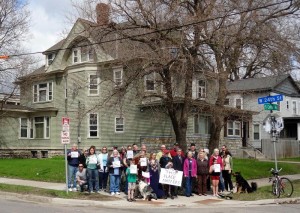
“This Place Matters”, photo taken for uploading to the National Trust for Historic Preservation’s gallery of photos of “places that matter.” May 2014.
Crow then appealed to the City Council. In his “Determination of Historic Eligibility,” Crow sings the same tune, this time with ad hominem attacks (presented here verbatim): “The entrenched foes of new development encouraged the self promoting amateur historian, working in conjunction with a striving TV starlet to generate letters of opposition from folks ignorant of the property. Unwittingly damaging the Preservationist’s cause. With cries of wolf at every new development credibility is diluted, further inhibiting incubation of sound policy. Not everything can be preserved, but if anything it should be the masterpieces. 2320 Colfax was far from a master piece [sic] when it was built much less after three fires, one of which took off the second and third floor.
There is very little left at the property which was built by Mr. Healy.[…]The appellant cites original woodwork, leaded glass and a middle room of the first floor having a fire place. These peices [sic] will surely be saved prior to demolition if they have value. However approximatly [sic] 400 square feet of a total building square footage of over 4,400 means ‘little interior fabric’ of the original remains intact.”
At the April meeting of the Zoning and Planning Committee of the City Council, Crow and Smoley gave basically the same testimony as presented at the HPC. This time, Crow got what he wanted. The committee reversed the previous decisions by the HPC and City Council.
On a motion from new Z&P Chair Lisa Bender, who has publicly supported the Lander development from the outset, the committee approved Crow’s appeal. A month later, the full City Council voted 11-2 to issue the demolition permit for an historic resource. One of the dissenters was 5th Ward CM Blong Yang, who had in fact toured the house. CMs Elizabeth Glidden, Cam Gordon, Barb Johnson, Kevin Reich, and John Quincy, all of whom a year before had declared the house an historic resource, reversed course, and voted for demolition.
When the Healy Project took Mike Crow to District Court for his plans to demolish an historic resource, once again Crow and Smoley repeated their testimony that the upper floors had been burned and rebuilt, that the interior fabric was destroyed, that the house had no integrity of materials, etc., etc.–this time under oath.
These are the facts. All testimony is taken verbatim from the public record.
“. . .at the length, the truth will out.” The Merchant of Venice, Act 2.
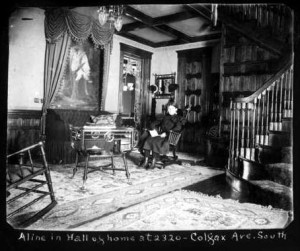
The entry hall at the turn of the last century from the Orth Family photo collection.–Photo courtesy Keith Lawrence.
Next: The testimony by the owner’s broker, Tom Dunn (Terra Firma Commercial); the developer’s hired historic preservation expert, Amy Lucas (Principle, Landscape Research); and Pete Keely (Collage Architects) of the Lander Group Development Team–all of which repeated the initial claims of owner Mike Crow.
–T.B.
Attorney Erik Hansen reports that this afternoon Judge Frank J. Magill, Jr. denied the Healy Project’s request for an injunction against the demolition of 2320 Colfax Avenue South, a.k.a. the Orth House.The judge will issue the rationale for the decision at a later date.
This decision comes as no surprise, as the house is already torn apart in preparation for the Lander Group’s backhoes. However, the Healy Project fully intends to take its case to the Court of Public Opinion, where voters, taxpayers, and concerned citizens can decide whether the political process that took down the historic house at 2320 Colfax was fair, unbiased and uncorrupted.
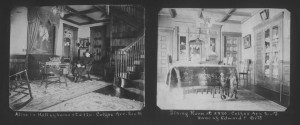
Orth family photos showing the entry hall and dining room of 2320 Colfax. Many of the architectural features shown here are now for sale at City Salvage & Antiques–Photos courtesy Keith Lawrence
Update: In early December, workers at the house told neighbors that Crow owned the house and would be demolishing it before Lander bought the property. Crow’s attorney told the judge that Lander would take possession on December 22nd, the day after the judge would be ruling on the TRO. On New Year’s Eve at the end of a story on 2320 featuring Anders Christensen, KSTP-TV reported that Mike Crow still owns the house and is responsible for demolition. Crow was not available for comment.
Did Crow lie to his attorney, or did his attorney lie to the judge in expectation of getting a $950k bond in case the judge issued the TRO? Or is there another explanation of these conflicting reports? Did the closing take place on the date claimed? Inquiring minds want to know.
To view the KSTP-TV story, click here.
–T.B.
What a difference two weeks makes. Earlier this month, a salvage company began removing architectural components of the Healy house at 2320 Colfax Avenue South in preparation for its demolition. The number of architectural items that came out of that house stunned even those of us who had never believed that nothing was left of Healy’s original 1893 house: fireplaces, doors, millwork, tiles, stained and leaded glass. The items salvaged are now for sale on City Salvage & Antique’s web site, marketed for the exquisite art they are, worth a small fortune.
A subcontractor of City Salvage on December 5 reported: “They wisely got the glass out first. They were busy tonight removing the raised-panel cherry wainscoting from the entry hall and stairs. The oft-discussed original first floor front facade is in fact still there, hiding inside the enclosed porch. Bay windows and bow window side by side, both intact inside and out. They also found a covered ox-eye window on the north wall of the second floor.
All the large doorways communicating 2320’s entry hall, parlors and dining room, each of which had been filled in with drywall and cheap hollow interior doors [by owner Mike Crow], were found still to have 6′-wide, paneled sliding doors hanging intact in their pockets. The Healy signature tile floor uncovered in the vestibule is being removed, destined for re-purpose as a table top.”
These are all things that demolition proponents, including the developer, the owner’s broker, and two preservation experts, claimed repeatedly weren’t there– before the neighborhood association, the Heritage Preservation Commission, the Minneapolis City Council, and, under oath, before District Court.
Photos and video taken on the second floor of 2320 last week and presented in District Court shows that owner Michael Crow gave misleading testimony, repeatedly claiming that the second and third floors were gutted in the reconstruction after the fire in 1991. The details revealed by the salvage operation show his claims to be false. Tom Dunn (real estate broker) of Terra Firma Commercial, the Lander Group (developer), Amy Lucas (historic preservation expert), and City Planner John Smoley all repeated this false testimony. Did they know it to be false or did they fail to do their due diligence?
Anders Christensen and Trilby Busch went on record 43 years ago (November 1981 Twin Cities Magazine article Legacy of a Master Builder) contending that 2320 Colfax is an important part of Healy’s architectural legacy. This claim was made long before the house was threatened with demolition.
In April of 2013, owner Michael Crow told the Minneapolis Heritage Preservation Commission that “everything on the second floor was completely gutted. . .There just isn’t much of the house left.”
Smoley repeated Crow’s misleading testimony: “The interior has been completely lost.” Lucas echoed this, saying, “I don’t know if any of you have been in the house but when it burned, the second and third floors burned completely. So they were rebuilt as small rooms upstairs, so there are sheet rock walls and metal doors.” Dunn summed up these comments with, “There just really isn’t anything worth saving in the building.” Despite these assertions, the HPC declared 2320 an “historic resource.” In May of 2013, the City Council upheld this decision.
However, after the 2013 election, Michael Crow came back to City Hall singing the same tune, but this time to more receptive ears. In March 2014 on a motion by chair Lisa Bender, the Zoning and Planning Committee granted Crow a demolition permit for an historic resource.
Last May, the Healy Project filed suit in District Court to stop the demolition of this historic resource. The case never made it to the trial stage. The Healy Project failed to get a temporary restraining order (TRO) in large part because Crow, Dunn, Smoley, and Lucas once again repeated the false claims initiated by Michael Crow. Since then, the suit has remained on the docket, minus an injunction against demolition.
After the recent revelation that the vast majority of the interior and exterior of the house was intact, the Healy Project decided to revisit the lawsuit. On Friday, December 19th, attorney Erik Hansen appeared in District Court before the Hon. Frank Magill, Jr. to request a TRO, based on the documented revelations of the salvage operation.
Bethany Gladhill, a credentialed expert on historic preservation, testified that in her professional opinion 2320 would be eligible for listing in the National Register of Historic Places, especially if it were included in a Multiple Property Listing of Healy houses in Lowry Hill East. She called 2320 a “transitional” Healy house, in fact, the “lynchpin” in that transition of designs. In her opinion, 2320 has strong integrity of place, of workmanship, and of materials. She respectfully disagreed with several of the findings and the conclusion of Amy Lucas’s report.
Michael Crow’s attorney Steven Harris said the closing between Michael Lander’s development company and Crow is set for Tuesday. It will be Michael Lander’s responsibility to demolish 2320 and the neighboring house at 2316. Crow will receive $950,000 for both properties; Harris requested a bond in that amount if the TRO is granted. A ruling is expected on Monday, December 22nd.
Did Crow lie to his attorney, or did his attorney lie to the judge in expectation of getting a $950k bond in case the judge issued the TRO? Or is there another explanation of these conflicting reports? Did the closing actually take place on the 22nd? Inquiring minds want to know. T.B.]
The next two posts provide detailed documentation of the series of misrepresentations in the testimony of Crow, Dunn, Lucas, Smoley, and the Lander Group throughout the two-year-long series of hearings regarding 2320 Colfax.
“There is only a negligible amount of original trim inside, which is really not worth saving, there’s nothing special about it.” Tom Dunne, President, Terra Firma Commercial, Real Estate Services
“Fires in 1991 and 2011 have left very little interior fabric.” Amy Lucas, Principal, Landscape Research
“Over 75% of the original materials in the home have been replaced due to extensive fires and insensitive remodeling.” Lander Group Development Team, submitted by Collage Architects.
If the above evidence doesn’t convince you that this whole process was poisoned from the start, here are some more statements presented to decision-making bodies, courtesy of Brian Finstad:
“There is not one single room that is in its original state. The only two rooms that are the most intact in the entire building are the foyer or entry and the original living room with fireplace.”
– Mike Crow – Colfax Addendum – 8 Jan 2014
“Besides some wood door frames there is little original fabric at the interior.”
– Amy Lucas, Landscape Research – Report to Pete Keely – 14 Dec 2012
“The interior has been completely lost with the rooming house conversion and fire repairs.”
– Amy Lucas, Landscape Research – Report to Pete Keely – 14 Dec 2012
“Fires in 1991 and 2011 have left little interior fabric . The second and third floors have been completely rebuilt”
– Amy Lucas, Landscape Research – Report to Pete Keely – 14 Dec 2012
“As is common knowledge, the property has endured a number of fires throughout its history with the last fire essentially removing the upper two floors.”
– Assessment of Economic Feasibility of Rehabilitation – Tom Dunn, Terra Firma Commercial – undated
“There is only a negligible amount of original trim inside, which is really not worth saving, there’s nothing special about it. There is one noteworthy concave window on the north side that will be saved, along with a fire place and whatever else there is of value.”
– Assessment of Economic Feasibility of Rehabilitation – Tom Dunn, Terra Firma Commercial – undated
“… the home is nothing close to the original construction. Over 75% of the original materials in the home have been replaced due to extensive fires, and insensitive remodeling.”
– Letter to HPC – Lander Group Development Team; Collage Architects – 17 Feb 2014
“Nearly all of the construction above the first floor and most of the first floor are not Healy constructed components as these have all been replaced… The second and third floors of the structure were gutted down to the studs… nearly all architectural integrity was removed from these two floors …over 70% of the first floor was changed.”
– Letter to HPC – Lander Group Development Team; Collage Architects – 17 Feb 2014
“Fire has gutted the top two floors. Approximately 600 sq.ft. of the total interior has any remains close to the original… There is a fireplace covered with newer construction.”
– Letter to HPC – Lander Group Development Team; Collage Architects – 17 Feb 2014
“The developer will take steps toward preservation. A full photo-documentation of the property interior and exterior will be completed.”
– Letter to HPC – Lander Group Development Team; Collage Architects – 17 Feb 2014
“The second and third floors were burned and the 1992 rehabilitation removed flooring, walls and doors. The plan of the upper floors was also changed during the renovation.”– Historic Evaluation – Amy Lucas, Landscape Research – Mar 2014
Update: On 12/31/2014 KSTP-TV aired a story on 2320 Colfax, featuring an interview with Anders Christensen. To view the story, click here.
–T.B., C.A.C.
Developers repeatedly trot out claims based on the tenets of New Urbanism: affordability, diversity, easy access, and sustainability. For example, as seen in the previous post, the Lander Group’s promotion of its 2320 Colfax project as “affordable” is not credible, given the rents required for units in new Wedge buildings. However, the Lander Group’s bogus claim of affordability is not the most egregious subversion of New Urbanist principles. A much more serious misrepresentation resides in the statement that this building will consist of “‘Eco-Flats – promoting ‘Green-Living’. . .close to and providing a variety of transportation options, services, recreation, and green space.”
What does this mean? Not that the building is green, but that the living in it will be green. How will this be green? By the developer putting in fewer parking spaces than will be needed for 45 units, providing an HourCar, a “variety of bike storage options”, and a bike-repair stand. First of all, the assumption that the majority of tenants won’t own cars is ridiculous. That’s an ideal of New Urbanist planning that is far from being realized. 80% of American adults own at least one car. If the project has the Wedge average of 1 1/2 tenants per unit, the complex could be short of parking by 34 spaces. Many workplaces are simply not accessible by public transportation, and many people who bike to work often suspend bike commuting during the winter. Second, the amenities available nearby (bus routes, bike paths, HourCar, parks, nearby shops and restaurants) are already there, and will be there, Lander project or not.
Using the prefix “Eco-” as a descriptor is a marketing ploy to suggest that this project will be good for the environment–which it most decidedly will not be. Wrecking the houses at 2320 and 2316 will cost the developer about $60k–to be added to construction costs–and would involve removing 250+ tons of building materials, excluding the foundations, to the landfill. Historic preservation is environmental preservation. According to the World Bank, “sustainable development recognizes that growth must be both inclusive and environmentally sound to reduce poverty and build shared prosperity for today’s population and to continue to meet the needs of future generations. It must be efficient with resources and carefully planned to deliver both immediate and long-term benefits for people, planet, and prosperity.”[1] The proposed Lander development at 2320 Colfax is decidedly inefficient in its use of resources. Ironically using the rhetoric of ‘green living,’ the developer seeks to destroy the Orth House and replace it with new construction–the least environmentally responsible option available.
Article after article about conservation reiterates the point that “green building” is an oxymoron. You can’t have both. As Jerri Holan, a Fulbright scholar and member of the AIA, points out: “The facts are in – no matter how much green technology is employed, any new building represents a new impact on the environment.It makes no sense for us to recycle newspapers, bottles, and cans while we’re throwing away entire buildings and neighborhoods.It’s fiscally irresponsible and entirely unsustainable.” [2]
The Minneapolis Heritage Preservation and City Council have determined the Orth House to be an “historic resource.” Razing historic buildings results in a triple hit on scarce resources. First, we are throwing away thousands of dollars of embodied energy. The greenest thing we can do is to continue the life of a building whose resources have already been extracted from our planet. Using data from the Advisory Council on Historic Preservation, we can calculate that the Orth House, at 6,400 square feet, embodies roughly 9.6 billion BTUS of energy, equal to 77,000 gallons of gasoline. If that building is torn down, all that embodied energy is wasted. What’s more, the demolition process itself consumes energy.[3]
The Lander website claims that their project would use “better construction techniques.” Hmm–better construction than what? Certainly not better than the house currently standing at 2320, which was built by T.P.Healy in 1893 of lumber from Minnesota’s virgin forests. The historic Orth House would be replaced with materials vastly more consumptive of energy. What is the Orth House built from? Timber, plaster, limestone, and bricks. These are the least energy consumptive of materials. The major components of new buildings, by contrast, are the most energy consumptive–plastic, steel, vinyl and aluminum.
An important part of New Urbanist strategy is the preservation of existing buildings and historic architecture. The reasons for this are twofold: historic preservation not only saves “places that matter” for future generations, but conserves rapidly dwindling natural resources and energy sources. The fact that the Lander project is a larger building than the Orth House does not offset the energy consumed in destroying the old one and building the new. Even if this building were LEEDS (Leadership in Energy and Environmental Design)-certified[4] and built on an empty lot (which it is not), it would take many decades to offset the loss of resources. “By 2030, we will have demolished and replaced nearly 1/3 of our current building stock, creating enough debris to fill 2,500 NFL stadiums. How much energy does this represent? [E]nough to power California (the 10th largest economy in the world) for 10 years. By contrast, if we rehabilitate just 10% of these buildings, we could power New York for over a year.”[5]
New building can never be greener than existing structures, yet Minneapolis keeps saying it espouses sustainability while demolishing dozens of buildings annually. At the root of the problem is the functional life of new buildings. Contemporary buildings are considered to be disposable even as they go up. Take, for example, the Metrodome and the 1981 Walker Community Library building. These structures stood on sites cleared of older buildings for their construction. Only three decades years later, they both were demolished, sending thousands of tons of building materials to landfills. Meanwhile, across the street from the third Walker library, the first 1911 Classical Revival library building still stands, adaptively reused as commercial space.
New Urbanism is a comprehensive philosophy of urban planning. But so far, Minneapolis has been dealing with demolition on a case-by-case basis. An owner wants to wreck an historic resource: staff representing City Planning say, sure, wreck away. . .There are better examples of Healy’s work. This process of finding better examples of this and that can go on until there is literally one Healy house left standing. Lander’s development could have a suitable place in Minneapolis, but not on the site of the Orth House. If 2320-2316 were vacant lots, the Lander project would have already been built. Minneapolis should not be curating a museum, but maintaining community character and identity.
Minneapolis must develop a policy dealing with demolitions that takes into account both historical and ecological resources. Marketing buzz words should not be a substitute for responsible urban stewardship.
“Our duty is to preserve what the past has had to say for itself, and to say for ourselves what shall be true for the future.”–John Ruskin
–T.B
C.A.C.
In promoting their new projects, developers repeatedly trot out claims based on the tenets of New Urbanism: affordability, diversity, easy access, and sustainability.
“New Urbanism promotes the creation and restoration of diverse, walkable, compact, vibrant, mixed-use communities composed of the same components as conventional development, but assembled in a more integrated fashion, in the form of complete communities. These contain housing, work places, shops, entertainment, schools, parks, and civic facilities essential to the daily lives of the residents, all within easy walking distance of each other.”–NewUrbanism.org

Want to live in hip, starry-neon-skied Lime in the Wedge Greenway, where (as their sign proclaims) “tarts” are welcome? Prepare to shell out big bucks for a small space.
Let’s look at the claims of the Lander Group for its proposal at 2316-2320 Colfax Avenue South and see how they square with the aims noted above. Lander wants to wreck the Orth House at 2320 to clear the site for a 45-unit apartment building. The Lander website says that the 2320 project is “geared to more affordable budgets with the smaller sizing, and real transportation options.” To be cost-effective for the developer, the rents in new units need to be set at least at market rate. Currently, rents for 500-square-foot studios in new Wedge buildings start at $1200 per month. This is not “affordable” housing by any stretch of the imagination. Even if Lander/At Home do as stated keep the rent under $1,000 to start with (still above average for the area), there’s nothing to stop them from raising it afterward. This is exactly what happened at the joint Lander-Gerberding apartment project at 46th and 46th. They were initially advertised as market rate [1], but now are luxury [2]. If the developer is serious about affordability, let him sign a contract with the City for a fixed-rent range.
The fact is that the older rental units are the affordable ones. New apartment construction, to be cost effective for the developer, must have rents set higher than for existing structures. The result is what we now have in the Wedge Greenway: 1800+ units built or under construction that are inhabited largely by young, affluent white people. The aim of the marketing campaigns for these Greenway apartments is to attract young suburbanites to the city for a few years before they settle down in neighborhoods of mostly single-family homes: “Don’t get hitched until you enjoy your year at Lime”, “I don’t remember her name, but her apartment” (Elan). This kind of marketing and pricing does not produce a racially, socially or economically diverse community, but an enclave of privileged “urban tourists,” slumming in the Wedge for a few years. So much for developers adhering to the “diversity” and “affordable” parts of New Urbanist planning.
The Lander website touts “real transportation options” (as opposed to imagined options?) available to future tenants. “The building concept promotes ‘green’ living – close to and providing a variety of transportation options, services, recreation, and green space.” Lander’s “concept” has not produced these amenities, which are available to anyone living in the area. Bus lines run on Hennepin, Lyndale, and Franklin right now.The Wedge has always been a very walkable part of the city, close to lakes, parks, and shopping. Minneapolis is currently the most bike-friendly city in the country. Hour Cars are available now at Franklin and Dupont, a short walk away; bike racks can be built into any structure.

In addition, the developer and development supporters totally ignore New Urbanism’s mandate to conserve resources: to lift people out of poverty, to use energy wisely, and to build community. An important part of this mandate is to preserve the cultural resources and history of the community–an aspect developers conveniently forget, and in fact, as is obvious in the case of 2320 Colfax, scorn.
“Regional architectural styles, historic preservation and shared public space are also crucial.”—Charter for the New Urbanism
This is what the idealized sketch of the proposed Lander building looks like:

Architectural drawings are often out of context, a building surrounded by sky and trees (and sometimes a flock of birds). This building could go just about anywhere, a ho-hum block of flats that is hyped as “affordable” and “sustainable”–but isn’t. (See post on “Greenwashing Demolition). Imagine instead an adaptive reuse of the Orth House, designed to fit in with new residential construction on the site, a multiple-unit complex that would not require sending 250+ tons of building materials to the landfill.

“Cities grow, evolve and combining the new with the old in the same area will acknowledge the history of the place. Projects that pay homage to the existing fabric of a space, but also incorporate new architecture would be my ideal.”–Martina Ernst, Wo-Built Inc. – Innovative Design and Build, Toronto
The Lander proposal is designed with one primary goal: to maximize profits for the developer, with no regard for the neighbors or neighborhood. Let’s not forget that the Lander project did not win approval by the LHENA neighborhood board.
Lander, the property owner, and their for-hire expert contend that the Orth House does not have structural integrity. But don’t just take the word of people who will make hundreds of thousands of dollars from its demolition. John Jepsen of Jepsen Structural Services, a company specializing in structural shoring, lifting and straightening, has examined 2320 Colfax. Last year he testified before the City Council that the house is structurally sound, “built of old growth timber, straight and true.”
The owner and the broker who engineered the deal with Lander also contend that it would economically unfeasible to rehab the house. Again, are we to simply take the word of those who will reap substantial financial gain from its demolition? Those who have been inside the house, like myself, have found that many of the original features remain on the first floor and on the exterior.The upper floors were redone after a fire, but this provides interesting options for redesign.
A redevelopment that would include the Orth House would be the green, sustainable, affordable option, a reuse that would be sensitive to community concerns, city history, and fit in with existing buildings in the North Wedge.
Reuse. Reinvest. Retrofit. Respect.
–T.B.
Answer: The one standing.
So says Carl Elephante, Director of Sustainable Design at Quinn Evans Architects. Last year, the National Trust for Historic Preservation released a study, “The Greenest Building: Quantifying the Environmental Value of Building Reuse,” with data that supports this contention. The report uses Life Cycle Analysis (LCA) to compare the relative impacts of building renovation and reuse versus new construction. The description of the study says that it “examines indicators within four environmental impact categories, including climate change, human health, ecosystem quality, and resource depletion.”
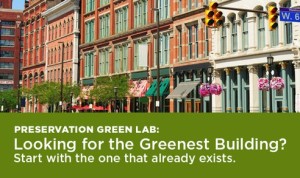 |
| copyright, National Trust for Historic Preservation |
According to the study, wrecking a building and replacing it with a new one comes with very high environmental and economic costs. Let’s look at what how these costs apply to the wrecking of the historic Orth House at 2320 Colfax Ave. S.in order to build the Lander Group’s new four-story apartment building:
First is the cost of destroying the existing structure. Wrecking the Orth House (and its neighbor at 2316) will cost the developer approximately $30,000 each. Add to this cost, the waste of the building materials of the house. The Orth House, a large 6,000+-square-foot house, is estimated to weigh 180 tons, not including the foundation (John Jepsen, Jepsen, Inc.). The Orth House was built in 1893 of lumber from Minnesota’s virgin forests. This irreplaceable resource will be hauled off to a landfill, never to be used again. The plaster, lath, windows, and mechanical systems will similarly be trashed. Yes, some of these features could be removed for salvage; however, the sad fact is that staircases, doors, and windows in a house of this size and vintage cannot easily be fitted into an existing structure. To reuse them, one would have to custom build a structure they could fit into. And what’s the point of that when they are already serving their purpose in the existing house?
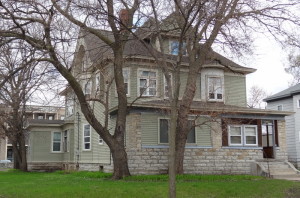 |
| The Orth House today. |
Second is the cost in labor and materials to build the new structure. New construction consumes many resources. The developer’s claim about energy savings makes no sense because new construction consumes so much energy upfront in producing new materials. (U.S.Green Building Council) The proposed apartment building is not one that uses a variety of “green” features and technologies, but a run-of-the mill structure. Recycling bins and bicycle racks do not a green building make. In fact, according to the Trust’s study, when replacing an average existing building with a new, more efficient building, it still requires as many as 80 years to overcome the impact of the construction.
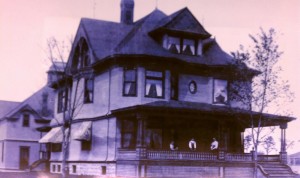 |
| The Orth House c. 1900 |

Recycling existing buildings is essential to creating sustainable cities.
Minneapolis, do the right thing: Support sustainability and save the historic Orth House from the landfill.
–T.B.


